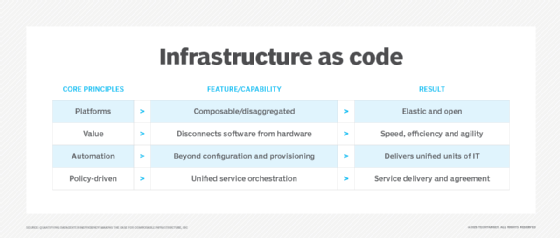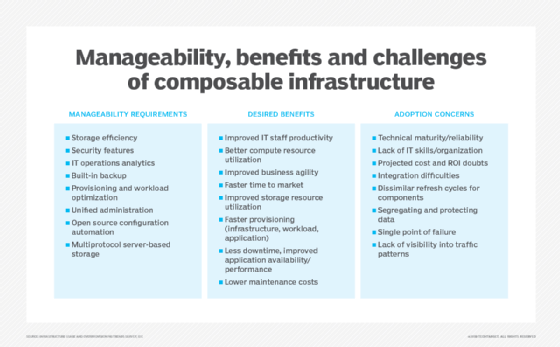
xy - Fotolia
Composable infrastructure techniques for the real world
Automating your composable infrastructure engenders flexibility that enables enterprises to reshape the data center and keep pace with today's cultural and technological shifts.
The data center architectural environment has morphed from a single stack to one that exists on a wide spectrum. The traditional three-tier data center is at one end, while the other is redefined on a continual basis as enterprise IT architecture vendors bring new capabilities to all aspects of the stack.
Hyper-converged infrastructure mashes up servers, storage and hypervisors into single appliances and, increasingly, newly integrated silos of infrastructure through such technologies as disaggregated hyper-converged infrastructure. Hyper-convergence has been a game-changer for many organizations seeking to simplify the data center equation, and it's accomplished that goal handily.
More and more, organizations need infrastructure stacks that are simple to implement and provide the flexibility to be turned into whatever application layer is needed. This application layer has to be fully programmable via APIs that can manage every part of the environment.
The goal is to decouple individual resources from their hardware. In turn, those resources are pooled and turned over to the management layer, which automatically cobbles together any resource combination to satisfy specific workload demands. Composable infrastructure is a native infrastructure-as-code architecture, which seeks to ensure that all infrastructure is fully programmable and can participate as manipulatable objects in a programmable infrastructure environment.

Bear in mind that composable infrastructure offerings can include physical, virtual and container-based hardware to provide a fluid and flexible workload environment.
Cloud-like resemblance
Whereas hyper-converged infrastructure closely resembles legacy infrastructure constructs, composable infrastructure looks and acts far more cloud-like -- a key use case. It's also well suited for modern development environments, including container architectures, that are virtually constructed and deconstructed on a regular basis. The pooled resource characteristic of the technology enables fine-grained and constant manipulation of those resources to take just about any shape necessary.
This brings composable infrastructure far closer to public cloud-like outcomes than is generally achieved with other technologies. Organizations can begin to enjoy real private clouds that have far more in common with public clouds than on-premises environments typically enjoy. Also, through inclusion in DevOps workflows, composable environments can self-manage and instantiate resources as needed, without necessarily requiring the intervention of an operator.
That automation is a key part of the composable infrastructure value proposition. Although most purveyors of composable offerings build in powerful software to enable automation, the fabric of the architecture lends itself to being programmed by developers. This enables automation to be part of the infrastructure's natural state and not an afterthought.

The technology is eminently suitable when the pace of change is great and waiting for IT operations teams to make manual changes would be too slow. This focus on constant construction and deconstruction makes composable infrastructure well suited for environments in which continuous development is the norm. Although non-composable architectures can support continuous development methodologies, the fully programmable capabilities of composable infrastructure make it a native candidate for such needs.
Digital transformation leads the charge to flexibility
A key use case for composable infrastructure revolves around digital transformation. Organizations undertaking such efforts need architectures that can keep pace with the cultural and technological shifts that must take place. Real transformation can't occur without a change in mindset around how infrastructure needs to exist in the data center. Even for those that don't want to or can't adopt the public cloud, enabling a fluid IT environment on premises is not only possible but essential.
The nature of the cultural shift associated with digital transformation means an organization can't afford for the infrastructure to become a roadblock. It has to be flexible and, just as importantly, highly scalable to meet the needs of applications both large and small.
It's not just a matter of implementing a bit of new hardware. Composable infrastructure enables organizations to reshape the data center to be whatever it needs to be. The success or failure of organizational initiatives rests on the flexibility of this architecture.







